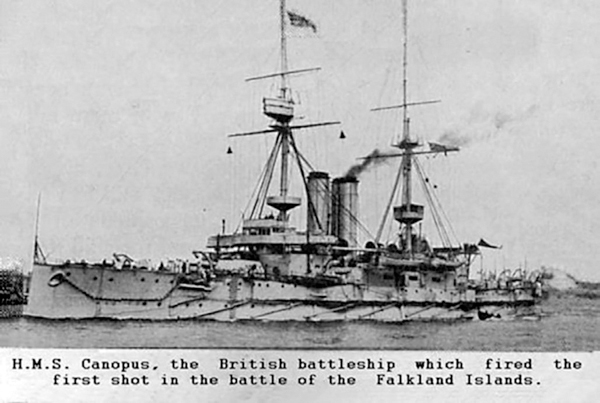
HMS Canopus.
T he Royal Sovereigns were commissioned into the Navy during the years 1892–4, when a political rapprochement between France and Russia was developing towards ultimate alliance. This bond, at first derided by political cartoonists in England as the union of Beauty and the Beast (Marianne and the Russian bear), had serious repercussions, not least for naval policy. France’s building programme of 1891 matched that of Britain by planning for ten new battleships and forty-five cruisers and caused considerable alarm. Although currently the Royal Navy had a margin of two battleships over the combined fleets of her two potential adversaries, a forecast showed that by 1898 this would have become a twenty-two to twentynine deficit. It was therefore decided that, as a matter of urgency, at least seven and preferably ten new battleships should be laid down in the years 1894–5.
Nine Majestics were built, to form with the Royal Sovereigns a homogeneous main battle fleet. Slightly larger than their immediate predecessors, the Majestics had a similar speed and the main armament of four 12-inch guns in two hooded barbettes, which was to be the standard for the remaining pre-dreadnoughts. Improved armour and an endurance of 7,600 miles at cruising speed made these the bestbalanced capital ships of their time, and all were still in service in 1914. At this stage, French battleships had a higher freeboard and huge funnels and masts, to give them the appearance known as ‘fierce-face’, which made them seem antiquated by comparison with their British counterparts. An exaggerated tumble-home in the five ships Charles Martel, Carnot, Jauréguiberry, Masséna and Bouvet enabled end-on fire from the 10.8-inch guns mounted as secondary armament on the beam, as well as the two 12-inch in single mountings fore and aft. The three ships of the Charlemagne class, with the larger Iéna and Suffren, each mounted four 12-inch in paired turrets, but the tumble-home was not reduced.
The Russians built in a similar style, beginning with the three ships of the Petropavlovsk class, armed with turrets of the French type, and continuing through to the Borodinos. Russian ambitions in Manchuria, and her leading part in the Dreibund (triple alliance of Germany, Austria-Hungary and Italy), which compelled Japan to surrender part of her territorial gains in the Sino-Japanese war, pushed Japan towards Britain. She had already ordered, in 1893, two ships of the Royal Sovereign type (Fuji and Yashima), to counter two Germanbuilt ships in the Chinese navy, and then four Majestics, enabling the overwhelming victory in the Russo-Japanese war of 1904–5. At Port Arthur, five Russian battleships, sunk or scuttled, were raised, refitted and served with the Japanese navy, while at the Battle of Tsushima Admiral Togo’s four battleships sank three old and three new Russian battleships and captured Orel which then saw service as Iwami. Britain not only built ships and trained key personnel for Japan, but in 1902 had signed a treaty of alliance. This enabled her to bring home ships from the Pacific, but also to keep in home waters the new Canopus class, originally intended for the China station.
Canopus and her five sisters were laid down between December 1986 and August 1898, all entering service by 1902. Displacing 2,000 tons less than the Majestics, they carried the same armament and were slightly faster. The three Irresistibles were improved versions of the Canopus class and were followed into service by the five ships of the London class, completed in 1904. By the time they had entered service the Fashoda Crisis in East Africa had been followed first by the Anglo-French colonial agreement and then by the diplomatic moves which led to the Entente of 1904. With this rapprochement, France ceased to be a potential enemy, and the later French battleships of the Republique and Vérité classes were to be allies.

HMS Canopus.
The new United States navy commissioned its first modern battleships in the 1880s, with the three Indianas mounting 13-inch guns and the similar Iowa with 12-inch guns. Eight more had been laid down by 1900, but these were not regarded as likely opponents for the Royal Navy. Their first action came in 1898, when Maine (recently reclassed as a second-class battleship instead of an armoured cruiser) blew up in the harbour at Havana. The accident was claimed to be sabotage and led to the brief Spanish-American War in which a US battle squadron blockaded Havana. Following a successful cruiser action at Manila Bay, the acquisition of the Philippines and Guam meant that the USA would now need a two-ocean navy and access across the Isthmus of Panama. The diplomatic activity necessary to create both the independent republic of Panama and the Canal Zone became a major preoccupation for the USA; the Canal itself was opened in 1914.
Nearer home, however, another new naval power was emerging. Since the creation of the German Empire in 1871, its navy had been a very insignificant force, with the Siegfried class of eight coastal defence vessels backed by cruisers and torpedo boats. The four Brandenburgs were the first true German battleships armed with six 11-inch guns and they were followed by the four Kaisers with only 9.4-inch main armament. A new emphasis on naval building came with the appointment of Grand Admiral Alfred von Tirpitz as Minister of Marine in 1897.
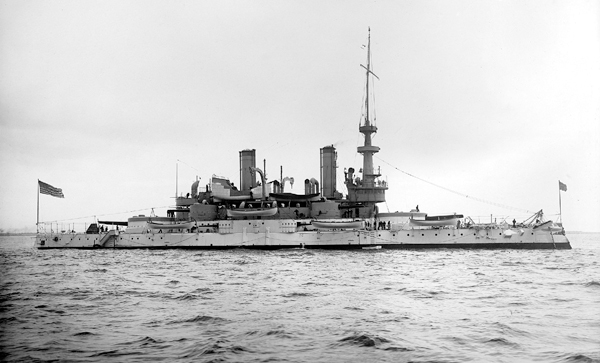
USS Indiana.
Pressure from the German Navy League for an Imperial Navy to match the strength of the army, and from the ambitions of the Kaiser, led to the Navy Law of 1898. This envisaged a battle fleet of nineteen ships by 1903 and entailed the building of ten new ships of the Wittelsbach and Braunschweig classes to add to the ships in service. These retained the lighter armament of their predecessors (9.4-inch and 11-inch respectively), and they proved to be of little fighting value when war came. Along with the two remaining Brandenburgs (whose two sisters had been sold to Turkey in 1910), they were all employed on harbour duties and most were ultimately disarmed. Zahringen was converted into a radio-controlled target vessel in 1926, but three of the Braunschweigs were retained as coastal defence ships in the 1920s, the other two serving as unarmed depot ships.
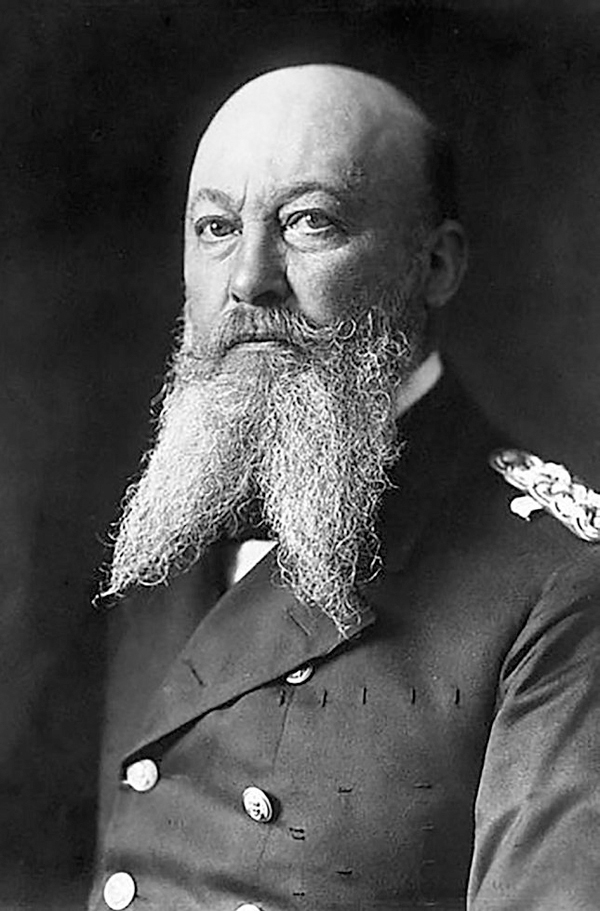
Grand Admiral Alfred von Tirpitz.
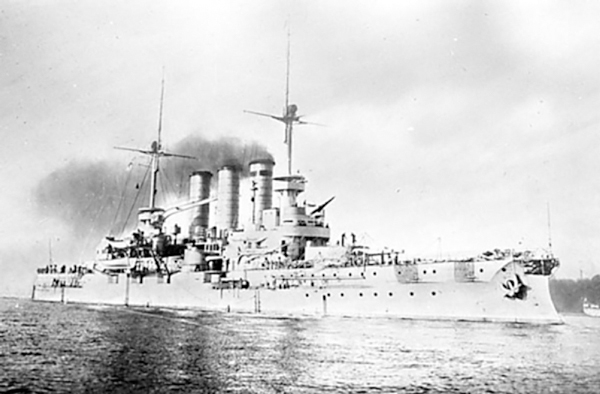
SMS Braunschweig.
A second Navy Law in 1900 revised the programme, establishing a new target for a battle fleet of thirty-eight ships by 1920. These would comprise four squadrons of eight ships, with four in reserve and two fleet flagships, which would give the German nation a fleet little inferior to that of Britain. It was apparent that the ships had a short range with cramped crew quarters, the ships’ companies, when in harbour, living in barracks ashore. They were clearly designed for operations in the North Sea. Tirpitz had evolved a ‘risk’ strategy, creating a fleet so strong that Britain could not afford to chance the loss of her naval supremacy by the damage which a clash of the two fleets would entail. This, he reasoned, would give Germany massive diplomatic bargaining power.
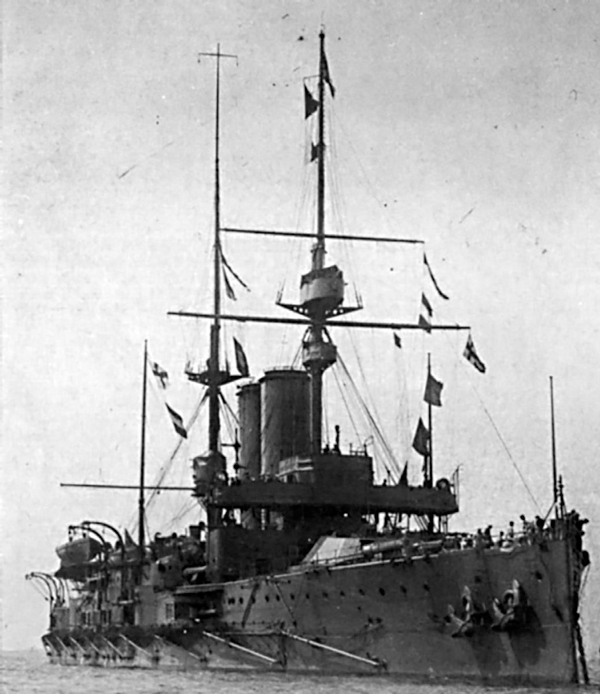
HMS King Edward VII.
There had been little concern in Britain over the initial German plan: in 1898 the Royal Navy had the sixteen ships of the Royal Sovereign and Majestic classes already built, six of the Canopus class building, and eight more of the Formidable and London classes planned – all vessels superior in every way to the German ships. Britain’s advantages in design experience and in dockyard capacity should, it was felt, keep her well ahead. The 1899 programme envisaged the six Duncans, designed to be a match for the latest Russian ships, and mounting four 12-inch and twelve 6-inch guns. Further additions to the fleet were the two second class battleships building at Barrow and at Elswick for the Chilean Navy. The 10-inch Libertad and Constitucion were bought and renamed Triumph and Swiftsure. Like their earlier namesakes, they were originally destined for the China station, but were sent to the Dardanelles in 1915.
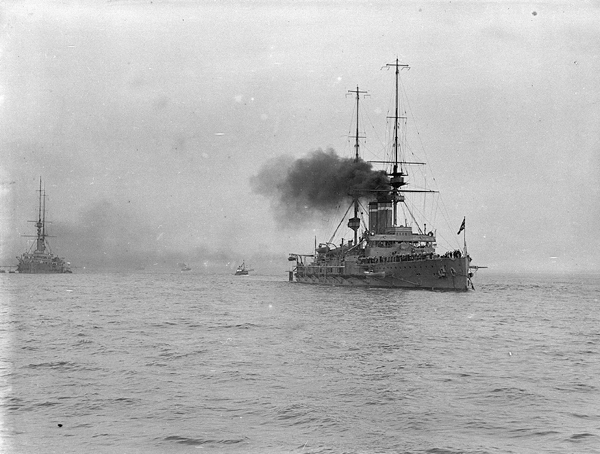
Battleship HMS Dominion at anchor at Spithead. (© National Maritime Museum, Greenwich, London)
The first direct response to the German building programme, outlined in the second Navy Law, was the King Edward VII class. These eight vessels, each of 16,350 tons, were larger than any earlier ships and mounted, in addition to a main armament of four 12-inch guns, a secondary battery of four 9.2-inch in single turrets on the upper deck. In 1912 Africa was used for an early experiment in naval aviation when the first take-off from a ship was achieved from a platform built over one of her turrets, while later in the year a similar venture aboard Hibernia saw the first take-off from a ship under way.
The last two pre-dreadnoughts built for the Royal Navy were laid down in 1905 and continued the innovation of a secondary battery of 9.2-inch guns – no fewer than ten of them, all mounted in upper deck turrets, to the complete exclusion of the 6-inch battery. Construction of Lord Nelson and Agamemnon was delayed by the priority given to Dreadnought (even their 12-inch main armament being diverted) and they did not enter service until 1908. They were considerably more powerful than the ships building in Germany at the same time: the five Deutschlands were still armed with 11-inch guns.

HMS Agamemnon.
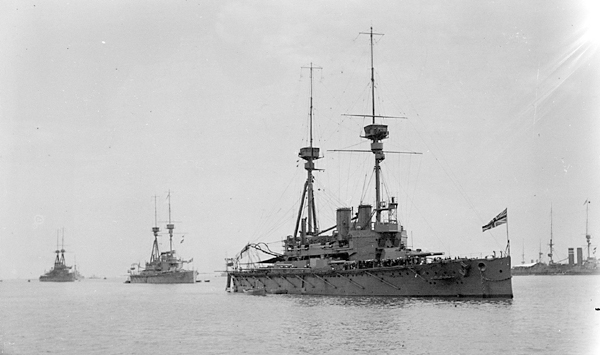
Battleship HMS Agamemnon at anchor at Spithead, with awning rigged aft and Lord Nelson astern of her. (© National Maritime Museum, Greenwich, London)
The French had laid down, between 1901 and 1903, two Républiques and four Vérités, abandoning some of the more exaggerated features of their older ships, but still taking so long to build that they were almost obsolete before they entered service. Of these Liberté blew up at Toulon in 1911. The next class, the six Dantons were similar to the Lord Nelsons in that they each had a secondary battery of twelve 9.4-inch guns, but they were not in service until 1911.
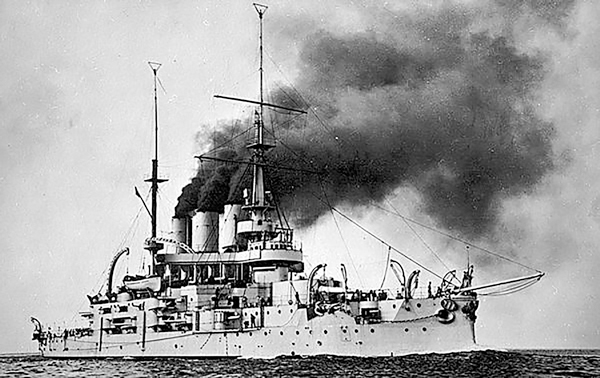
Russian pre-dreadnought Kniaz Potemkin.
The Russian navy had suffered grievously in the war with Japan, from which she emerged with seven elderly battleships, of dubious value even as coastal defence vessels. Only two ships, Potemkin and Tsesarevitch had been completed since 1900 and both owed much to French influence in their design. Potemkin was part of the Black Sea fleet, gaining her niche in history when her crew mutinied in Odessa in 1905; she subsequently relived that event when she was the setting for Eisenstein’s film ‘Battleship Potemkin’ celebrating the heroism of the mutineers.
To these was added the Slava, last of the Borodinos, fortunate to have been completed a month after Tsushima. Only four more predreadnoughts were built: two of the Evstafi class and two Imperator Pavels which joined the Black Sea and Baltic fleets in 1910.
The prizes taken by the Japanese at Port Arthur and Tsushima proved of limited use as fighting ships. Two saw service as coastal defence ships, three as guard ships and two as training vessels: only the Retvisan saw active service under her new name of Hizen. The last two battleships built in British yards for Japan were the Kashima and Katori, similar to the King Edwards, but with a secondary battery of 10-inch guns. Four smaller ships were built in Japan by 1909, while the Aki and Satsuma were laid down in 1905. Intended originally for an all-big-gun armament, they were completed as ‘intermediate dreadnoughts’ of the Lord Nelson type, with four 12-inch and twelve 10-inch guns.
Italy and Austria-Hungary, though members of the Triple Alliance with Germany, were rivals for territory in the Tyrol and Istria and their naval strength was built up with a keen regard for one another. Italy, for whom Benedetto Brin had been a resourceful and original designer, had lagged so far in naval construction that in 1900 she possessed only four obsolete battleships as guard-ships with two more as disarmed depot vessels. Two 10-inch gunned ships of only 9,800 tons were ready by 1902, and were based in Venice, while the larger Benedetto Brin and Regina Margherita took station at Brindisi. Four ships of the Regina Elena class of 12,750 tons and armed with only two 12-inch and twelve 8-inch guns were ready by 1908 and were based at Taranto. To counter this fleet the Austrians too had a collection of old ships, and a succession of very small battleships mounting no more than 9.4-inch guns. The three of the Wien class were appropriately rated as coastal defence ships, but the Habsburgs were seen as sea-going battleships, despite their meagre 8,340 tons and three 9.4-inch guns. The three Erzherzog Karls were only a marginal improvement, and it was not until 1911 that the Austrians possessed three full-size ships, the Radetzky class of 14,500 tons and with four 12-inch and eight 9.4-inch, comparable with the King Edwards of a decade earlier.
Not only the major powers were intent on deploying battleships. The South American republics followed suit, placing orders in European and American yards, while Greece and Turkey, as ever eying one another nervously, each purchased two old vessels from America and Germany respectively. The Scandinavian countries and the Netherlands were content with coastal defence ships.
The American navy, however, continued to grow. Twelve modern battleships were in service by 1904, by which time the turrets and 13-inch guns of the earlier vessels had given way to hooded barbettes and 12-inch guns in the more recent. The five Virginias of the 1902 programme (all in service by 1906) were comparable with their contemporaries in the Royal Navy in that they each displaced 15,000 tons and were armed with four 12-inch and twelve 6-inch guns. They differed in that they mounted four of their secondary battery of eight 8-inch guns in paired turrets, on top of the 12-inch main armament. This was intended to give a better field of fire, but in practice problems caused by blast made the system unworkable and it was not attempted again. The six Connecticut class of the 1903 programme were of a more conventional layout, with all the 8-inch guns in paired turrets on the beam. They were followed by the smaller and slower Mississippi and Idaho which later were sold to Greece and renamed Lemnos and Kilkis. By the time of their completion in 1908, however, the design for the South Carolinas had triggered a new era in battleship construction.